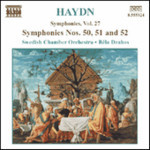
Haydn: Symphonies, Vol. 27 (Nos. 50, 51 & 52)
 $25.00
Out of Stock
$25.00
Out of Stock6+ weeks add to cart
JOSEPH HAYDN
Haydn: Symphonies, Vol. 27 (Nos. 50, 51 & 52)
Swedish Chamber Orchestra, Bela Drahos
[ Naxos / CD ]
Release Date: Saturday 22 December 2007
This item is currently out of stock. It may take 6 or more weeks to obtain from when you place your order as this is a specialist product.
Joseph Haydn was born in the village of Rohrau in 1732, the son of a wheelwright. Trained at the choir-school of St Stephen's Cathedral in Vienna, he subsequently spent some years earning a living as best he could from teaching and playing the violin or keyboard, and was able to profit from association with the old composer Porpora, whose assistant he became.
Haydn's first appointment was in 1759 as Kapellmeister to a Bohemian nobleman, Count von Morzin, whose kinsman had once served as patron to Vivaldi. This was followed in 1761 by employment as Vice-Kapellmeister to one of the richest men in the Empire, Prince Paul Anton Esterházy, succeeded after his death in 1762 by Prince Nicolaus. On the death in 1766 of the elderly and somewhat obstructive Kapellmeister Gregor Werner, who had found much to complain about in the professionalism of his young and resented deputy, Haydn succeeded to his position, to remain in the same employment, nominally at least, for the rest of his life.
On the completion of the magnificent palace at Eszterháza in the Hungarian plains under Prince Nicolaus, Haydn assumed command of an increased musical establishment. Here he had responsibility for the musical activities of the palace, which included the provision and direction of instrumental music, opera and music for the theatre, as well as music for the church. For his patron he provided a quantity of chamber music of all kinds, particularly for the Prince's own peculiar instrument, the baryton, a bowed string instrument with sympathetic strings that could also be plucked.
Prince Nicolaus died in 1790 and Haydn found himself able to accept an invitation to visit London. There he provided music for concert seasons organized by the violinist-impresario Salomon. A second successful visit to London in 1794 and 1795 was followed by a return to duty with the Esterházy family, the new head of which had settled principally at the family property in Eisenstadt, where Haydn had started his career with them. Much of the year, however, was to be spent in Vienna, where Haydn passed his final years, dying in 1809, as the French armies of Napoleon approached the city yet again.
Haydn lived during the period of the eighteenth century that saw the development of instrumental music from the age of Bach and Handel to the era of the classical sonata, with its tripartite first-movement form and complementary two or three movements, the basis now of much instrumental composition. The symphony may claim to have become the most important form of orchestral composition and owes a great deal, if not its precise paternity, to Haydn. He first attempted such composition some time before 1759 and wrote his last symphonies for London in the last decade of the century.
On 31st August 1773 the Empress Maria Theresa and her court visited Eszterháza. The first day brought a play in the palace theatre, followed the next day by Haydn's opera L'infedeltà delusa, and in the magnificent ball-room, with its chinoiserie decoration, a masked ball, at which Haydn and his musicians appeared dressed in what was described as Chinese fashion. On the third day a marionette opera, Philemon und Baucis, for which Haydn provided music, was performed, its distinctly patriotic dénouement followed by fireworks. The occasion seemingly brought a performance of Haydn's Symphony No. 48 and it has been suggested that Symphony No. 50 might also have been played for the Empress, its first two movements derived, perhaps, from the Prologue to Philemon und Baucis, with two additional movements to make up a complete symphony. The work is, in any case, in scoring and key, designed for a festive occasion, with its trumpets and drums. The first movement starts with a stately introduction with formal dotted rhythms, leading to a characteristic Allegro, the repeated exposition with a shortened second subject, material to be developed in a central section, before returning in recapitulation. The G major slow movement is entrusted principally to the strings, with the oboes only marking the recapitulation. The Menuet starts with the ascending notes of the C major triad, as in the first movement. The Trio brings a surprise, starting as it does with the same figure as the Menuet, but moving then to an F major oboe melody, and then to an E major conclusion, before the return of the Menuet. The last movement has only one theme, which returns with the necessary shifts of key, both in its second appearance, in the central development, and in the final recapitulation.
Tracks:
Symphony No. 50 in C major
Symphony No. 51 in B flat major
Symphony No. 52 in C minor

